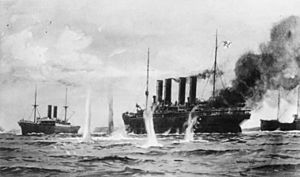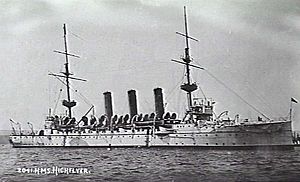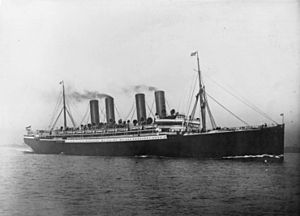Sinking of SS Kaiser Wilhelm der Grosse facts for kids
Quick facts for kids Sinking of SS Kaiser Wilhelm der Grosse |
|||||||
|---|---|---|---|---|---|---|---|
| Part of the Atlantic U-boat campaign of World War I | |||||||
 |
|||||||
|
|||||||
| Belligerents | |||||||
| Commanders and leaders | |||||||
| Strength | |||||||
| 1 protected cruiser | 1 auxiliary cruiser | ||||||
| Casualties and losses | |||||||
|
1 cruiser scuttled | ||||||
The Battle of Río de Oro was a naval fight that happened in August 1914, during World War I. It was a clash between a British warship, HMS Highflyer, and a German ship, SS Kaiser Wilhelm der Grosse. The battle took place off the coast of Northwest Africa, near a place called Río de Oro.
Contents
Ships in the Battle
The German Ship: SS Kaiser Wilhelm der Grosse
The German ship, SS Kaiser Wilhelm der Grosse, was commanded by Max Reymann. It was originally a large passenger liner, built in 1897. When World War I started, the German navy took it over. They added six 4-inch guns and two smaller 37-millimeter guns to turn it into an armed ship. Its mission was to attack enemy merchant ships in the Atlantic Ocean.
The British Ship: HMS Highflyer
The British ship, HMS Highflyer, was a protected cruiser built in 1898. It was commanded by Henry T. Buller. This ship was much more heavily armed than the German vessel. It had eleven 6-inch guns, nine 12-pounder guns, six 3-pounder guns, and two torpedo tubes. The Highflyer was sent to help find and stop the German ship.
The Battle Begins
The battle happened on August 26, 1914. The German ship, Kaiser Wilhelm der Grosse, was caught by surprise. It was in a harbor, taking on coal from three other ships. These ships were German and Austro-Hungarian coal supply vessels.
The British ship, Highflyer, had many more guns and was much stronger. It first asked the German ship to surrender. However, the German commander said that the British were breaking Spain's neutrality. This meant they were fighting in waters that belonged to a neutral country.
The British ignored this argument. They said the Germans had already broken Spain's neutrality. The German ship had spent over a week getting supplies in a neutral port. So, the battle began.
The Fight and Sinking
The two ships fired at each other from 3:10 PM to 4:45 PM. They tried to hit each other while also dodging incoming shots. Eventually, the Kaiser Wilhelm der Grosse ran out of ammunition. It tried to escape the battle.
The German crew then decided to sink their own ship. This is called "scuttling." They made sure the ship would sink so the British could not capture it. After scuttling the ship, the crew managed to get to shore. They then escaped into the Saharan Desert.
What Happened After
At first, British reports said that their ship, Highflyer, had sunk the German auxiliary cruiser. But later, stories from the German sailors who survived came out. These stories showed that the Germans had actually scuttled their own ship. Even so, the British were still responsible for the German ship's end.
The Kaiser Wilhelm der Grosse was the first passenger liner to be sunk during World War I. Part of the ship remained above the water, making it easy to identify. The wreck stayed there until it was taken apart for scrap metal in 1952.
In the battle, one British soldier was killed. Six other British soldiers were wounded. The number of German casualties is not known.
See also
 In Spanish: Batalla de Río de Oro para niños
In Spanish: Batalla de Río de Oro para niños



